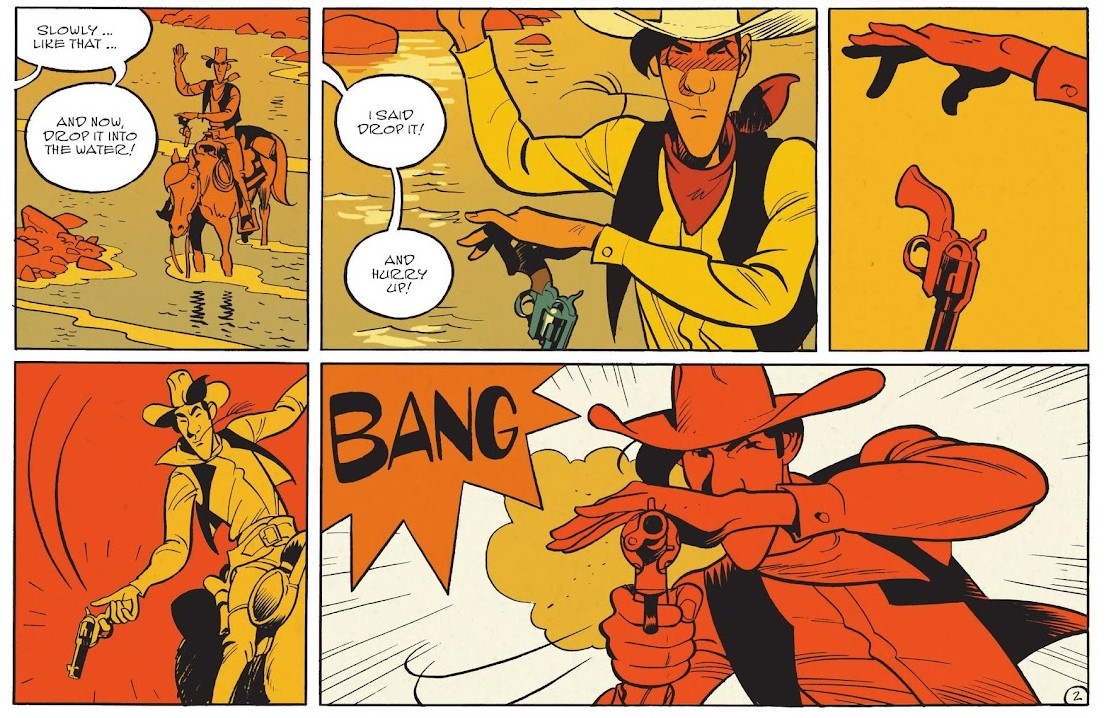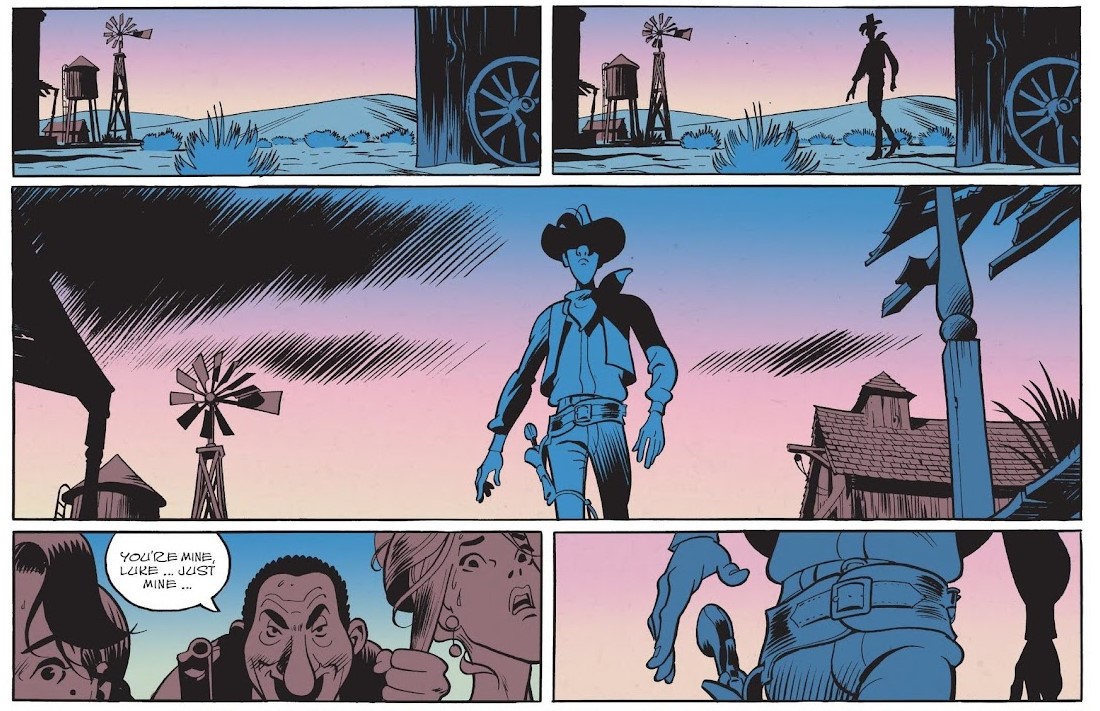I first became acquainted with Matthieu Bonhomme through The Marquis of Anaon, a five-volume adventure series written by Fabien Vehlmann, published in English via Cinebook. It featured a rather wet blanket protagonist going on a series of globetrotting adventures and encountering all sorts of weird phenomena. It is not a particularly well-written series; the character never elicits much interest and the plots all feel overtly familiar, but is still worth reading for the art of Bonhomme.
A phenomenal visual storyteller, existing somewhat in the post-Alex Toth school of eliminating all that is spurious and drawing the hell out of what’s left, Bonhomme is especially notable for his use of color. The third of volume of Marquis takes place almost entirely onboard a ship - physically dammed and spiritually damned. It is marvelous to view Bonhomme drawing the passage of time without making note of it: the sun reddening, the greyness of the sea in a storm, darkness rising at night. Keeping to the horror atmosphere of the tale without needing to use exaggeration - finding fear in the colors of real life.

So I was understandably excited with the possibility of Bonhomme drawing and writing something by himself, unencumbered by the mediocrity of Vehlmann, even if said project is of the ‘IP maintenance’ type. Wanted: Lucky Luke is the second of two volumes Bonhomme has written and drawn in the long-running western series, starring the eponymous cowboy; it was preceded by The Man Who Shot Lucky Luke. While often regarded as more artistic-minded than mainstream American comics, the world of Eurocomics has its own long-running properties that have outlived their original creators and continue to wring money from the pockets of (I assume) mostly the nostalgic. Lucky Luke was created by the cartoonist Morris (Maurice de Bevere) in 1946 and has been in publication ever since; Morris' death in 2001 didn’t hurt the publication one bit, as artist Achdé (Hervé Darmenton) continues to plug away with various writers at keeping the spirit alive.
Which is another way of saying: Lucky Luke has been a bit like a zombie for quite a while. Like their American corporate counterparts, what has begun as the quirky self-expression of one individual’s artistic ability has long since ossified. Readers of current Lucky Luke stories don’t expect to be surprised: they expect to see the villainous Daltons escaping from prison, Jolly Jumper showing how clever a horse he is, and Lucky Luke shooting faster than his own shadow (though never to seriously harm anybody). And they expect to see it a faux-Morris style that evokes the series at its cultural and economic height. The edges of the character and creator, such as they were, has long been sanded off.

Which is why these Bonhomme stories appear so interesting. Wanted: Lucky Luke is part of a new subseries of continuity-free (as much as Lucky Luke was ever busy with continuity) adventures featuring a group of European writer-artists working on the title within their own style, using the world of Morris without being enslaved to his visual language. Lucky Luke Saddles Up (Mawil, 2019) and Swiss Bliss (Ralf König, 2021) look nothing like Morris, and probably feel either fresh or sacrilegious to longtime readers.
This approach reminds me a bit of early Vertigo comics, or DC's Black Label of late - take the familiar concept and see if you can give it new life in the form of a fresh coat of paint. Wanted: Lucky Luke specifically feels like something from the early Vertigo school: a story that is mostly about the nature of Lucky Luke stories. If not self-reflexive, it is at least highly self-aware. The plot involves Lucky Luke helping three sisters take their cattle through hostile territory, while himself being hunted by unknown forces (it appears that someone has a put a bounty on his head).
If this sounds somewhat familiar, it’s because you’ve heard it before: the second-ever Lucky Luke story, "Le Sosie de Lucky Luke" from 1947 (collected in English in the Cinebook volume Dick Digger's Gold Mine), involves a Luke look-alike that causes much confusion. That’s not the only familiar component. One of the bounty hunters after Luke’s head in Wanted is the son of Phil Wire (Phil Defer in French), a Jack Palance-looking villain from a 1950s Morris story. Another bounty hunter is a new Dalton relative. And others are… well, to be honest I’m not as hip on Lucky Luke lore (say it three times fast) as to recognize all of them. But I’m sure all these bad guy faces are familiar to longtime readers.

It can’t be a coincidence that the stories alluded to here are some of earliest works by Morris, from when the series was still finding its way - before Morris teamed with writer René Goscinny (of Asterix fame) for three decades of collaboration. In the early solo stories, Lucky Luke was a still a comedic figure—the series was always built of stereotypes and exaggerations—but he was allowed to be a bit of a scoundrel and a hard case. Dick Digger's Gold Mine and Phil Wire both feature Luke killing the antagonists - and, even more scandalously to parents of young, easily-influenced children, holding a cigarette in his mouth.

Both elements would disappear as the character grew in popularity; Luke would become even more saintly than the Lone Ranger, and the familiar straw piece would appear in his mouth instead of a cigarette. Just as the Hollywood image of the cowboy became more detached from the real thing as time went on and audiences learned to expect a great degree of mythic baggage from a western, so did Lucky Luke became detached from his original comics self.
Which is why ‘the story’ of Wanted: Lucky Luke doesn’t really work. There’s a lot of talk throughout about how Lucky Luke has changed; the bad guys mock Luke for no longer being a ‘real’ cowboy, while a group of beautiful sisters each fail to capture his heart – alluding to the need to keep the character unsexual in a manner befitting the morals of 1940s. Lucky Luke, Bonhomme seems to argue, is trapped within his own fame. He can’t be a ‘real’ cowboy, nor can he advance.
Not a particularly novel point, and none of these elements manage to coalesce into any grand statement about the nature of Lucky Luke’s character. Not that there’s much of a character to make a statement about; Lucky Luke is the straight man for a madcap reality - he's a vehicle for gags, not a figure of particular emotional depth. Any attempt by Bonhomme to manufacture some is doomed to failure.

Which is not to say you shouldn’t read Wanted: Lucky Luke. It looks great, with Bonhomme going even deeper into cartoonish territory than before: character eyes are tiny black dots, chins protrude from faces like outcrops, and body shapes of henchmen can reach nearly spherical proportions. It is all supremely expressive, and great fun to boot. An early page excerpted just above, showing Luke dropping his gun only to grab it mid-fall and shoot at a far-away enemy, is a marvel of economy. Every panel is centered around only the most vital element of the scene, going from an establishing shot of Luke on his horse, to a tight focus on the body, than to the hands preforming the action, and finishing in a single, wide panel of the dramatic moment - Leone would certainly approve.
Likewise impressive is Bonhomme’s color palette, an area in which he has few competitors. From the orange shades of the setting sun and the burning yellow of the desert in heat to the light blue of night scenes - it’s not ‘realistic’, but it manages to evoke real feelings of time and place. Bonhomme is a master, but he does not seek to overwhelm the reader with his skill, serving instead the mood and progression of the story.
Wanted: Lucky Luke isn’t a particular innovative tale, nor is it a smart one. It is, however, a joyful one. And that’s something I want more of.








